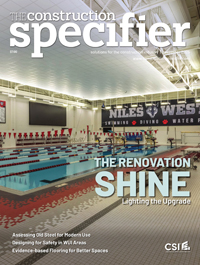Dealing with errors and omissions
Defensive strategies for reducing the cost of errors and omissions
If architects and their insurance companies believe any dialogue between the architect’s representative and the contractors will invariably lead to a perception that the design is open-to-interpretation (a risk they are unwilling to take), they will simply have to forgo perhaps the most powerful tool for minimizing the cost of errors and omissions—the contractor, who is the last party in a position to call out an error before it gets built into the project.
Having a second architect, engineer, or designer review an intern’s work is mostly a waste of time and money. The supervisor has likely not been present at all the meetings where decisions were made and just does not have enough time to do all the calculations a second time or to go over the whole process again.
There are a few good defensive strategies for minimizing the costs of errors and omissions. Of course, carefully examining a contractor’s quote for corrective work is among them. However, the best method is to encourage contractor’s superintendents to question aspects they suspect are in error, instead of building them into the project without question. Trade contractors have likely built many similar projects and are quite knowledgeable about what is questionable.
American Institute of Architects (AIA) General Conditions require contractors who become aware of errors or omissions to bring them to the attention of the architect/engineer (A/E). Most contractors consider it common courtesy to ask about suspected particulars. However, if the time frame for getting answers begins to slow their schedule or if they have to fight for compensation when it is due, they will not ask in the future.
The first opportunity to establish a working policy with contractors to encourage them to ask about suspected errors or omissions is during the pre-bid and post-bid interviews. Contractors’ knowledge of errors and omissions at this stage is limited, because the estimator and project manager who attend these meetings have only studied the drawings for bidding purposes. However, even at this stage, the contractor usually comes to the pre-contract meetings with several questions. It is important to respond quickly and set a pace for a constructive dialogue in the future.
It is typically in the morning, when the jobsite foreman is studying the drawings and assigning work for the day, when they come across suspected mistakes in the plans. Unfortunately, there is usually a crisis mentality at this moment, when he or she is ready to start work for the day. This is the last real opportunity to getting out ahead of errors and omissions. The architect should accommodate the foreman with a quick, written answer.
Architects unwilling to pursue this method for minimizing costs for errors and omissions is not doing their duty as the owner’s representatives.
Preparing the client
The best way to prepare the client for errors and omissions is to discuss the issue during contract negotiations. It should be approached in a businesslike manner as just another term of the agreement in the spirit of mutual benefits. At this point, the owner has made a decision, usually after careful deliberation, to hire the A/E and is unlikely to back out at the mere mention of errors and omissions.
There is a huge benefit to having this discussion when the decision-makers are still at the table, rather than later when lower level bureaucrats are asked to sign the first change order. Presidents, CEOs, and board members are comfortable with making difficult decisions, while lower level bureaucrats typically do not like making decisions. The CEO will look at the issue with the confidence of knowing he or she will not lose a job for creating policy; lower-level bureaucrats do not make policy, and confrontation could arise if they are pushed into that role.
When should the A/E pay for mistakes?
There is no hard and fast answer to this question. A mistake of a few thousand dollars on a small budget project can wreck the owner’s finances, whereas on a $50-million project, it is barely a hiccup. For this reason, using percentages as a threshold has limited usefulness without being specific about the scale of the project.
This author worked for an architect who made a point of discussing errors and omissions during contract negotiations. To one client who wanted a rule to control when the A/E would be asked to share in the costs of errors and omissions, the professional gave him a clause in the agreement: errors were not to exceed two percent of the budget ($50 million project) and errors and omissions combined were not to exceed three percent or a combined $1.5 million. The architect was comfortable with these numbers because they were familiar with the type and scale of the project and had completed several similar designs in the past. The project was a complete success, partly because the architect and client had an understanding going into the project that there would be a reasonable cost associated with the errors and omissions, and it never became an issue.
Paul Potts is a technical writer and construction administrator. He has worked in the construction industry as an independent contractor and administrator for architects, engineers, and owners in Michigan. Potts can be contacted via e-mail at paulpotts1@comcast.net.








